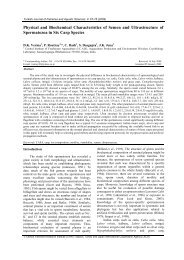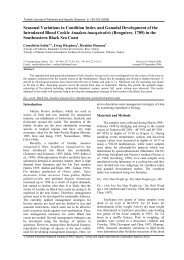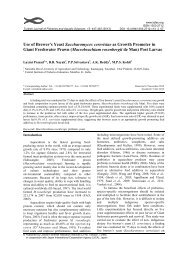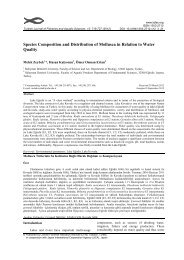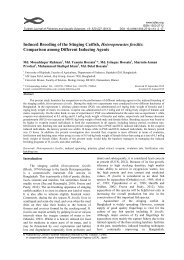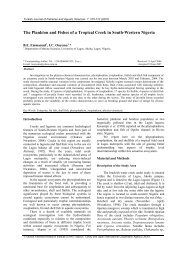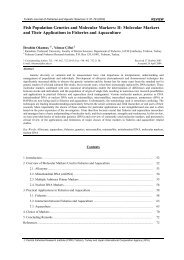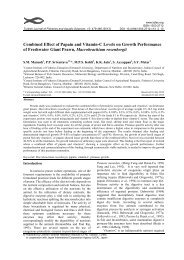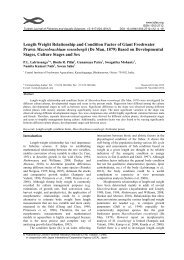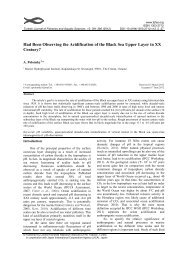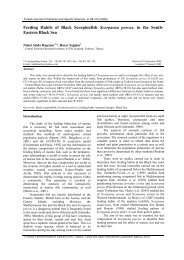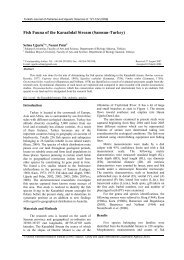Commercial Fishery Impact on the Modern Black Sea Ecosystem: a ...
Commercial Fishery Impact on the Modern Black Sea Ecosystem: a ...
Commercial Fishery Impact on the Modern Black Sea Ecosystem: a ...
- No tags were found...
Create successful ePaper yourself
Turn your PDF publications into a flip-book with our unique Google optimized e-Paper software.
78 V. N. Eremeev and G. V. Zuyev / Turk. J. Fish. Aquat. Sci. 7: 75-82 (2007)Table 1. Species compositi<strong>on</strong> of <strong>the</strong> <strong>Black</strong> <strong>Sea</strong> landings in <strong>the</strong> end of 1960s - beginning of 1970-s and in 1988s (%) (Ivanovand Bevert<strong>on</strong>, 1985; FAO yearbook, 2004)Species1960 - 1970ss 1988sThousand t<strong>on</strong>nes % Thousand t<strong>on</strong>nes %Anchovy 53.6* 67.7*Sprat 1.6* 69.88.6*93.4Horse mackerel 12.5* 12.6*Whiting 2.1*4.5*Atlantic b<strong>on</strong>ito 16.1 1.7Mackerel 1.2 1.5Bluefish 3.2 30.21.26.6Shad 0.8 0.2Turbot 2.0 0.2Picked dogfish 1.5 0.7Thornback ray 0.9 0.2Mugils 2.6 0.3Red mullet 1.7 0.5Sturge<strong>on</strong>s 0.2~ 0.01Total 182.8 100 783.8 100* Small short cycle fish speciesAno<strong>the</strong>r proof of <strong>the</strong> <strong>Black</strong> <strong>Sea</strong> fish overexploitati<strong>on</strong>evidences <strong>the</strong> decrease of anchovy of midsize and mid age in <strong>the</strong> end of 1980s testifying<strong>the</strong>reby “rejuvenati<strong>on</strong>” of <strong>the</strong> populati<strong>on</strong>. On <strong>the</strong>c<strong>on</strong>trary, weakening of fishing pressure <strong>on</strong> itspopulati<strong>on</strong> in <strong>the</strong> following years challenged a reverseeffect, namely, <strong>the</strong> size- age structure rehabilitati<strong>on</strong>and its catch increase (Figure 5). Thus drastic fall oftotal catches in 1989s might have been predictedbeforehand and <strong>on</strong>ly <strong>the</strong> emergence of two highlyproductive generati<strong>on</strong>s of horse mackerel in 1983sand 1984s arrested it for some years.In additi<strong>on</strong>, <strong>the</strong> imbalance in a “stock and catch”relati<strong>on</strong>ship in 1980s is exhibited in peculiarities of<strong>the</strong> l<strong>on</strong>g-term “stock and catch” dynamics indices. Asit is seen in <strong>the</strong> figure, <strong>the</strong> catch curve is equal in formto that of <strong>the</strong> stock retarding for 4-5 years (Figure 6).Thus <strong>the</strong> peak for <strong>the</strong> stock in 1979s wasaccompanied by peak for <strong>the</strong> catch in 1984s,minimum of <strong>the</strong> stock in 1983s was attended with thatof <strong>the</strong> catch in 1987s. And again <strong>the</strong> peak for <strong>the</strong>stock in 1984s was followed by <strong>the</strong> catch peak in1988s. It could hardly be regarded as incidentalcoincidence. Present temporal intervals corresp<strong>on</strong>d to<strong>the</strong> life span of <strong>on</strong>e generati<strong>on</strong> of <strong>the</strong> maincommercial species - anchovy and horse mackerelc<strong>on</strong>stituted in <strong>the</strong> end of 1970s more than 75% of totallandings. Correlati<strong>on</strong> coefficient value between stockwithin 1979-1987ss and catch within 1983-1991sswas equal to 0.748 (p < 0.02). In this c<strong>on</strong>necti<strong>on</strong>, <strong>the</strong>positi<strong>on</strong> of a number of scientists holding to <strong>the</strong> ideaof “<strong>the</strong> fatal” role of Mnemiopsis leidyi in sharpdecline of <strong>Black</strong> <strong>Sea</strong> catches doesn’t seem to be ra<strong>the</strong>rc<strong>on</strong>vincing.Phenomen<strong>on</strong> of Mnemiopsis “outburst” attainingits high point in 1989s suggests <strong>the</strong> directc<strong>on</strong>sequence of biomass decrease in small fishplanktophagous (anchovy, horse mackerel and o<strong>the</strong>rs)resulted from overfishing (Figure 7). Only due tosmall numbers of <strong>the</strong>se fish, Mnemiopsis leidyi turnedout to be competitive to <strong>the</strong>se planktophagous in agiven ecological niche. In 1988s as compared to1979s, <strong>the</strong> commercial fish stocks reduced more than<strong>on</strong>e and a half-fold: from 2200 thousand t<strong>on</strong>nes to1400 thousand t<strong>on</strong>nes. Finally, <strong>the</strong> ecological nicheoccupied by fish planktophagous appeared to bepartly empty and corresp<strong>on</strong>dingly, according to <strong>the</strong>general ecological rule “nature abhoret vacuum”,was occupied by Mnemiopsis.Al<strong>on</strong>g with Mnemiopsis, <strong>the</strong> crucial role instructural and functi<strong>on</strong>al alterati<strong>on</strong>s of <strong>the</strong> ecosystemin <strong>the</strong> north-west of <strong>the</strong> <strong>Black</strong> <strong>Sea</strong> played <strong>the</strong>extensive commercial bottom sprat trawlingscommenced in 1970s of <strong>the</strong> 20th century. Since 1979still 1986s, more than 120 thousand operati<strong>on</strong>s wereperformed in <strong>the</strong> NW shelf of <strong>the</strong> <strong>Black</strong> <strong>Sea</strong>. Ascompared to <strong>the</strong> previous period, <strong>the</strong> volume of spratcatch appeared to be increased as much as 15-20times during some years. Bottom trawling affecteddirectly <strong>the</strong> sea ecosystem by mechanic destructi<strong>on</strong> ofbottom biotops by trawlboard and low headline,respectively damaging or completely destroyingbenthic communities.Much more deleterious influence <strong>on</strong> <strong>the</strong>ecosystem was exerted by bottom sediments (peliticfracti<strong>on</strong>s) raised into <strong>the</strong> pelagic layer. It inducedsec<strong>on</strong>dary eutrophicati<strong>on</strong> and water polluti<strong>on</strong>, declineof its transparency, depressi<strong>on</strong> of photosyn<strong>the</strong>sisprocesses. However, <strong>the</strong> main negative factor ofbottom trawlings was recognized silting of vastbottom areas. Thus pelitic particles from TarkhancutCape of <strong>the</strong> Crimea peninsula spread with <strong>the</strong> currentfor <strong>the</strong> distance of 150-200 km (Figure 8). Totally,more than 5 thousand square km of <strong>the</strong> shelf weresilted as an outcome: at larger parts, <strong>the</strong> silt layerthickness varied from 2 till 5 cm, attaining up to 40-50 cm in spots. In a period of 1976-1984ss, some siltdepositi<strong>on</strong>s raised into <strong>the</strong> water layer c<strong>on</strong>stituting



